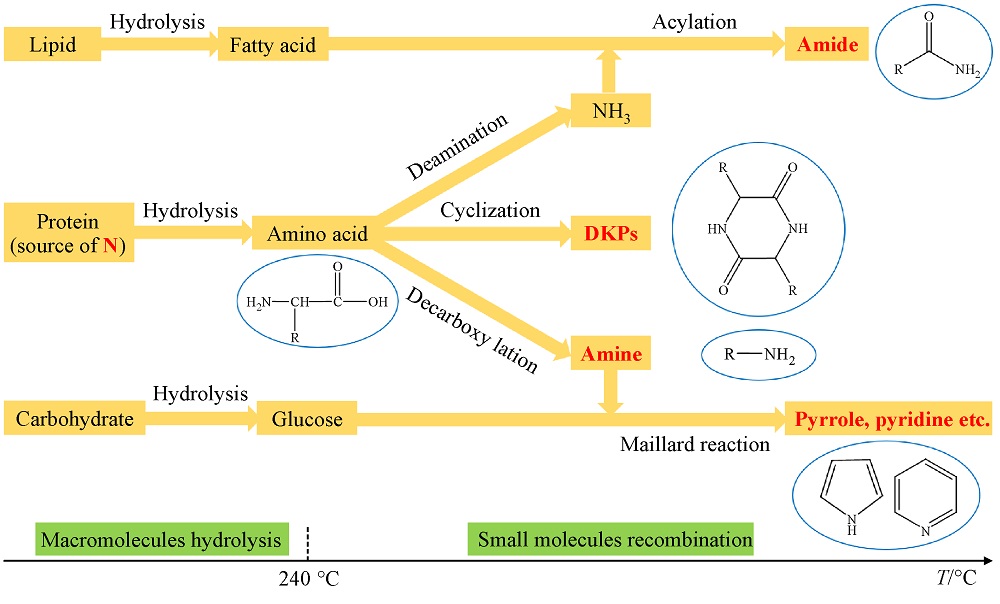However, the existence of nitrogen-containing organic compounds (NOCs) has always been a concern during utilization of microalgae as an energy source, in particular, via HTL process [
16]. As the biocrude obtained by HTL needs further refining optimization, and the high concentration of nitrogen-heterocyclic compounds such as quinoline, pyridine, etc. will make the catalyst used in the refining process toxic, so that the deactivation of the catalyst will cause great difficulties in refining the biocrude. In addition, NOCs and sulfides have a competitive relationship in the desulfurization process of biocrude which inhibit the desulfurization effect [
17]. Moreover, NOCs could also cause atmosphere pollution due to producing considerable NO
x in industrial applications [
18]. Therefore, various studies have proposed some methods to reduce the nitrogen content in biocrude. Chen et al. [
19] found that water extraction could reduce the nitrogen content in microalgae biocrude from 6.83% to 5.75%, which increased the carbon and hydrogen content simultaneously. Gas chromatography and mass spectrometry (GC-MS) of the biocrude had further confirmed that water could separate the fatty acid derivatives from biocrude, and these derivatives can be seen as a surfactant to emulsify NOCs to the aqueous phase. As a result, water is not only a conventional solvent, but also participates in some reactions which occur in organic phase during HTL. A two-step HTL process was developed by Miao et al. [
20,
21], in which proteins and polysaccharides were separated from the microalgae at first, and then the remaining algae residue was as the feedstock for HTL. Comparing with the one-step method, the contents of nitrogen and oxygen in biocrude obtained by the two-step method was lower. It proved that the two-step HTL process could improve the quality of biocrude, because it was almost using lipids as the raw material for the second step which increased the yield of biocrude and reduced the nitrogen content in the oil phase. The way of using biological macromolecule model compounds as feedstock may be more effective to study the reaction mechanism and pathway of nitrogen. Montero-Hidalgo et al. [
22] employed hydrothermal pretreatment at low temperatures of
Nannochloropsis gaditana for reducing the contents of nitrogen and oxygen in biocrude. Reaction temperature and residence time were key factors which having a negative impact on the biomass yield while a positive impact on the heteroatom recovery in aqueous phase. However, the effect of solid loading rate in feedstock on the two aspects was opposite from reaction temperature and residence time. Therefore, different reaction conditions have a significant influence on the yield and distribution of heteroatom, and at the same time, the selection of microalgae may also affect the reaction conditions. An alga called
Enteromorpha prolifera was investigated at different reaction conditions with using crude glycerol as solvent by Lu et al. [
23]. They discovered that crude glycerol could reduce the contents of nitrogen in biocrude and improve the yield. Thus, changing the reaction solvent might improve the characteristics of biocrude. Tang et al. [
24] researched flash heating method of
Nannochloropsis. In the products separation procedure, the aqueous extract was separated from aqueous phase by adding dichloromethane into the water solution. Dichloromethane is a commonly-used extraction solvent in the process of oil-water separation, because the boiling point of dichloromethane is lower than 40 °C which could be a benefit for the post separation and very cost-effective. Comparing with the conventional HTL, the biocrude yield obtained by the flash heating method was almost the same, but it could save the reaction time and improve the efficiency. And the separation of the aqueous extract could improve the biocrude yield by reducing the contents of NOCs. Therefore, the change of experimental method or separation procedure will have certain effects on the nitrogen distribution in products.














